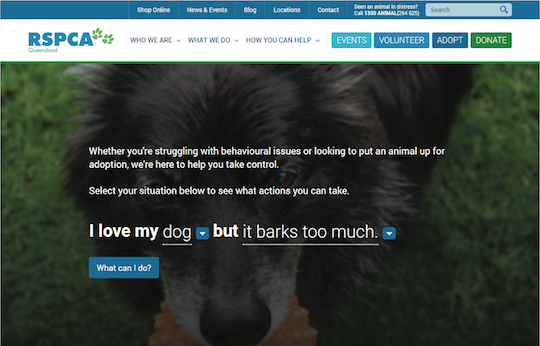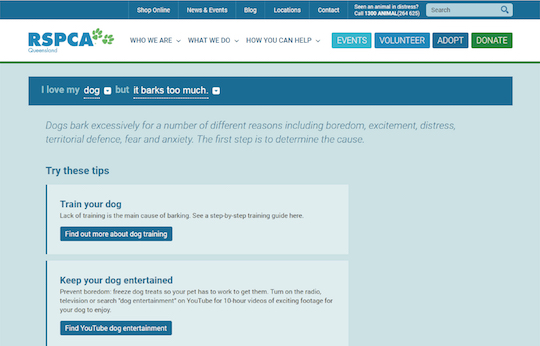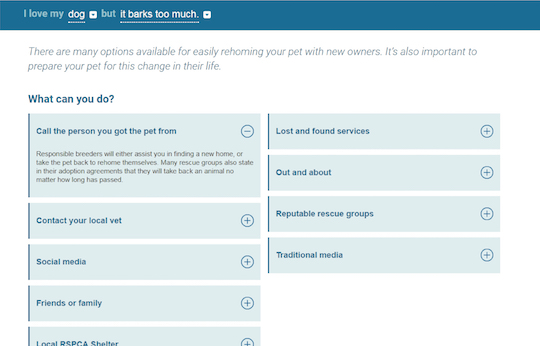Case study: how RSPCA Queensland solved pet peeves with better experiences
Share
For some brands, big success can bring big problems. RSPCA Queensland’s brand recognition meant that more pet owners were surrendering pets to its shelter, resulting in increased difficulty providing animal care and significant operational costs. A streamlined online solution delivered immediate results and slashed costs.
This article originally appeared in The Money Issue, our April/May print edition of Marketing magazine.
Campaign: Surrender Portal
Client: RSPCA Queensland
Agency: Liquid Interactive
Background
 For some brands, big success can bring big problems. The RSPCA is recognised and trusted all over the world. It’s Australia’s oldest and largest animal welfare charity, with each state and territory having an affiliated branch. RSPCA Queensland is the state’s most successful animal welfare charity, and is known as the largest animal shelter in the southern hemisphere. One of its services is to provide shelter and care to pets that are voluntarily surrendered by their owners. However, the service had become so well-known that up to 5000 animals were being surrendered each year in Queensland, all with their own specific care and rehoming needs. Shelters were reaching capacity, the call centre was overloaded and over $3.5 million was being spent on animal care costs for the surrender service alone.
For some brands, big success can bring big problems. The RSPCA is recognised and trusted all over the world. It’s Australia’s oldest and largest animal welfare charity, with each state and territory having an affiliated branch. RSPCA Queensland is the state’s most successful animal welfare charity, and is known as the largest animal shelter in the southern hemisphere. One of its services is to provide shelter and care to pets that are voluntarily surrendered by their owners. However, the service had become so well-known that up to 5000 animals were being surrendered each year in Queensland, all with their own specific care and rehoming needs. Shelters were reaching capacity, the call centre was overloaded and over $3.5 million was being spent on animal care costs for the surrender service alone.
Having recently redeveloped its headquarters in Brisbane, RSPCA Queensland was acutely aware of the cost and time implications for increasing capacity in its shelters. Instead, the marketing team decided to try a digital solution to reduce the volume of pet surrenders without compromising animal welfare. Utilising the behaviour change capabilities of digital agency Liquid Interactive, the team developed a solution to this complex, costly and distressing problem.
Objectives
RSPCA Queensland receives less than 3% of its $48 million operating costs from government funding. The remaining 97% must be raised from commercial operations and philanthropic support. Internal expectations are that every dollar spent should deliver strong ROI. The objectives were both simple and ambitious:
- Reduce the number of pets surrendered to RSPCA Queensland’s shelters by 10%.
- Reduce the number of pet surrender calls to the call centre by 10%.
- Ensure the innovation is sustainable and avoids ongoing costs.
Strategy
It began with a focus on customer motivations and touchpoints. The emphasis was on a detailed analysis of available data to enable a simple but targeted execution.
Phase one: understand the motivations for surrender
The data analysis phase began by asking ‘why are pet owners surrendering their pets?’
Knowing that the surrender process typically takes an hour from phone call to surrender, the team took the opportunity to leverage the organisation’s biggest repository of data and insights – the frontline staff. Call centre staff deal with cases all day, so we knew they understood surrender situations. They had already collated an extensive database of types of animals surrendered and what problems caused owners to surrender them – they had already captured 832 unique combinations of pet and problem.
The data provided important clues. If an owner is considering surrendering a pet, they are most likely experiencing difficulty related directly to the animal – for example, behavioural problems or barking – or something indirect like a relationship break-up, moving house or allergies. The most important, overarching insight was pointed out by one of the call centre staff: “Many owners who surrender their pets have preventable problems. They just need some help.” This pointed to the first part of a possible solution: persuading owners that they didn’t have to surrender their pet.
Phase two: understand the pathway to surrender
The data analysis phase began by asking ‘why are pet owners surrendering their pets?’
Knowing that the surrender process typically takes an hour from phone call to surrender, the team took the opportunity to leverage the organisation’s biggest repository of data and insights – the frontline staff. Call centre staff deal with cases all day, so we knew they understood surrender situations. They had already collated an extensive database of types of animals surrendered and what problems caused owners to surrender them – they had already captured 832 unique combinations of pet and problem.
The data provided important clues. If an owner is considering surrendering a pet, they are most likely experiencing difficulty related directly to the animal – for example, behavioural problems or barking – or something indirect like a relationship break-up, moving house or allergies. The most important, overarching insight was pointed out by one of the call centre staff: “Many owners who surrender their pets have preventable problems. They just need some help.” This pointed to the first part of a possible solution: persuading owners that they didn’t have to surrender their pet.
- Owners have a problem with their pet.
- Some search for help online.
- Advice is vague, unreliable and fragmented.
- Owners feel frustrated and helpless.
- They surrender their pet to the RSPCA.
There were two points at which this solution could intervene: getting advice on the internet; and surrendering an animal to the RSPCA.
With so many combinations of animals and reasons for surrender, all requiring specific messages, a standard marketing campaign would not be sufficient. But what if there were a one-stop website that had reliable advice for specific pet problems? If we educated owners about alternatives and offered support resources, could we help them keep their pets? The strategy for the RSPCA Queensland Surrender Portal was born: a new online experience that:
- interrupts the surrender process by ensuring the Surrender Portal appeared at the critical moment pet owners search for help, and
- provides realistic, specific and genuinely helpful advice.
Execution
The first step was creating and curating relevant content. Data analysis found that just 64 out of the 832 recorded pet problem combinations accounted for 83% of all surrenders. This majority became the focus. For each of these combinations Liquid either wrote helpful suggestions (based on RSPCA advice) or curated support resources and services. For instance, dog owners on low incomes can struggle to afford dog food, but the Surrender Portal can point out that it is a common donation item at local food shelters.
Liquid’s designers packaged the problems and solutions into a digital service that was placed in front of the existing pet surrender form. Now, before a customer can complete the surrender form they have to specify their situation. For instance, ‘I love my dog, but I can’t walk it anymore’ or ‘I love my guinea pig, but I don’t have time to look after it’. The use of the word ‘love’ was key because many owners really loved their pets and didn’t want to give them up. Based on their situations, the Portal provides targeted advice, and if that is not sufficient, then alternatives to surrendering are suggested – and only after the customer has said those options wouldn’t work can they get to the surrender form.
There was no announcement or promotional campaign for the release. Instead it was slotted into the site’s architecture and left for users to find as part of their existing journey.
Results
The impact was immediate. The day the portal was released, call centre staff noticed a drop in the number of calls. Over the last 12 months the results have averaged:
- a 22% decrease in surrendered animals – more than 1000 fewer pets every year, and
- $800,000 annual savings in animal care costs.
Given the entire project only cost $60,000, the savings in animal care costs have given RSPCA Queensland more than 13 times the return within the first year, without a single dollar going towards promotion. Call centre staff also noticed a change in the attitude of pet owners who do decide to surrender their animals. Prior to the Portal, callers often acted as if the process was entirely the RSPCA’s responsibility (some would even simply abandon their pets on the shelter’s doorstep).
It educated owners and shaped their attitudes and behaviour. Staff report owners taking more responsibility for the smooth transition of their animal to RSPCA care (supplying health records or care packages at handover, for example). For owners who really don’t want to give up their animals, RSPCA Queensland is now able to reach out at a crucial moment and provide solutions that help keep those pets at home.


















